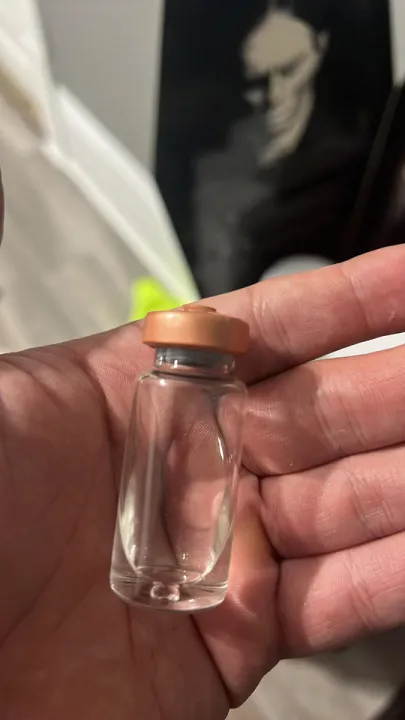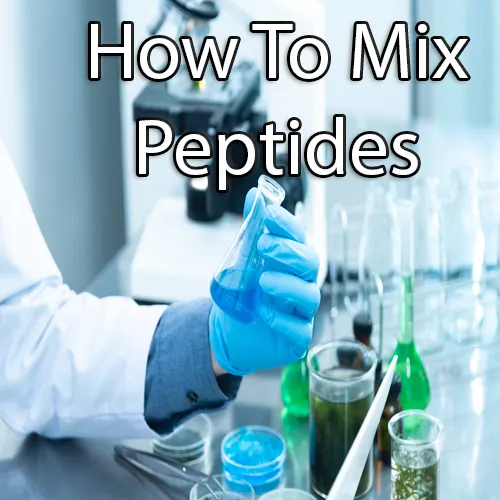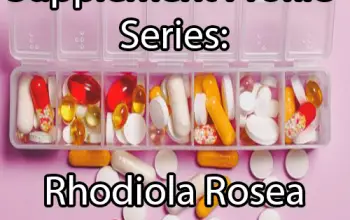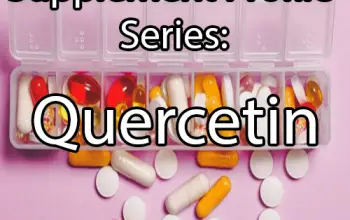*This post contains affiliate links throughout and at the end*
Introduction to Reconstituting Peptides
When it comes to getting a peptide or water soluble substance there’s a few issues.
When people have peptides, you notice something odd.
You have this weird, disc shaped powder.
Not an oil or water that’s ready for use immediately.
As a result, I get a LOT of questions or concerns from people.
Just to name a few common questions I see:
- What do I mix it with?
- How do I know how much solution to use?
- How do I calculate how much of the product I have per use?
- Is there any best practices to keep it shelf stable longer?
I’ll address all of these questions and more below.
Also, In the post I have linked a Peptide Calculator.
As always, please remember to read the plethora of disclaimers
“What do I mix my peptides with?”
9/10 the answer is “Bacteriostatic Water.”

Bacteriostatic water is sometimes colloquially called “Bac Water.”
Sometimes people will receive items in kits with “Sterile water for Reconstitution.”
Other times people will see “Acetic acid for reconstitution”
I’ll talk a bit more about each of these solutions briefly, but 99% of the time.. people use bac water.
why do people use Sterile water for reconstitution?
Sterile water as a solvent for your peptides is typically only in circumstances of SINGLE-use.
This is because properly sealed and stored sterile water is free of bacteria or adulterants.
However; once the vial is used, it now has the opportunity for bacteria or other agents to adulterate the water.
Sterile water is just pure water without any agents to help prevent bacterial growth.
However; Bacteriostatic water or acetic acid which work in slightly different ways to prevent bacterial growth.
Reconstitution with either of those is for multiple use products.
why do people use bacteriostatic water for reconstitution

Bacteriostatic water is a solution that typically contains 0.9% “Benzyl Alcohol” per solution as well as sterile water.
The Benzyl Alcohol works to prevent bacterial growth inside of the solution, due to the alcohol.
This also means that the solution created may have a longer shelf life because it won’t be easily degraded by adulterants.
Bacteriostatic water can overtime become worthless, especially after use.
A general rule of thumb people use: after 4 weeks, pitch the opened/used vial.
This is because of the potency from the Benzyl Alcohol is severely impaired from the exposure of other agents.
Why do people use Acetic Acid For Reconstitution?

Acetic Acid is a solution that contains 10ml sterile water that is typically diluted with 6mg of acetic acid.
Glacial Acetic Acid is pretty much purified Acetic Acid (it’s less than 1% water content)
It is much more expensive and not necessary.
Typically Acetic Acid is used for more PH sensitive Peptides: (like IGF1-LR3)
The general train of thought is that the alcohol used in bacteriostatic water will denaturize the peptide proteins faster.
As a result people aim to use Acetic acid for their suspension as it also has a 4 week shelf life.
With acetic acid via Intramuscular or Subcutaneous (subQ) use have issues with a burning sensation.
This is where people will use the acetic acid to reconstitute first, then sterile water or bac water to backfill the syringe before administering.
This dilution occurs AFTER suspension and ONLY in the insulin syringe, not in the vial.
Calculating how much to use
I used to have people check out PinfoBox for peptide calculations, however
I have recently found an OUTSTANDING WEBSITE.
Unlike Pinfobox, they currently do not charge you a monthly fee.
No, I am not affiliated with them, but this is insanely beneficial:
https://peptidecalc.com/#
You can literally pick your syringe size, amount of solution used and the amount you want per injection.
if you don’t have access to the website, here’s an example of the math behind figuring out your injection.
Example: (how much bacteriostatic water to mix with 5mg of bpc-157)
lets say I have a 5mg vial of BPC-157: If i want to get 250mcg per shot, how would I do that?
I have two of the THREE pieces of information needed, lets assume i have 1CC (1ml) insulin syringe.
Based off of that, I can do a simple conversion and calculation. Incase you didn’t know; 1000mcg= 1mg.
I can do basic multiplication to help solve the issue:
(1mg= 1000mcg) x 5 (the amount of BPC-157 in the vial)
5mg= 5000mcg
We know my syringe can hold 1cc/1ml of solution, so that’s not useful YET.
If I add ONE CC (ML) of bacteriostatic water to my BPC-157, I know I’ll have 5000mcg per vial
Now, since I’ve only added ONE ML of Bac water, If I have a 1ML Syringe that will fill it up ENTIRELY.
Each syringe has the amount of “Units” used. (also called TIC marks)
This is used to denote how much you are going to be injecting.
You can typically find 100 TIC mark 1 ML syringes easily on Amazon. (Purchase here, from an amazon affiliate link)
They’re going to have every 10 tics denoting a TENTH of a ML.
Now, if I draw to 10 units/ the 10-tick mark I’m using one-tenth of the solution.
That means my injection is 500mcg. (5000mcg/10 = 500mcg)
That’s more than I wanted. So that means I have TWO OPTIONS:
Add 1 more ML of bacterostatic water to get 250mcg per injection
OR just draw in-between half of the 0 and 10 tic marker.
Convenience would mean: For 5mg of BPC-157 you need 2ml of bacteriostatic water. (bac water link)
A short reference on common dosages for peptides
At the Request of a reader; here is a table with the peptide name, ML of water, and typical dosage utilized alongside a link to get some peptides from swisschems, an affiliate of the blog.
| Peptide Name | ML for Reconstitution | Typical Dose (1ml 100 tic Syringe ) |
| HCG (5000 iu) | 1ML Bac Water | 1000 IU (20 tic marks) |
| BPC-157(5mg) | 2ML Bac Water | 250-500mcg (10-20tic marks) |
| TB-500 (5mg) | 1ML Bac Water | 2.5mg (50 tic marks) |
| Follistatin (1mg) | 1ML Bac Water | 100mcg (10 tic marks) |
| HGH (10 iu Vial) | 1ML Bac Water | 1-4 IU (10-40 tic marks) |
| HGH-Frag (5mg) | 1ML Bac Water | 500mcg (10 tic marks) |
| GHRP-2 (5mg) | 2ML Bac Water | 100mcg (4 tic marks) |
| GHRP-6 (5mg) | 2ML Bac Water | 100mcg (4 tic marks) |
| IGF1-LR3 (1mg) | 1ML Acetic Acid | 100mcg (10 tic marks) |
Best practices for longer lasting products.
I talked about this in my previous post where I talk about supplements and their “expiration” dates.
But, if you don’t want to read all of that follow these instructions.
- Make sure to wipe down the tops of your vials with an Isopropyl alcohol pad before and after use.
- Do not adulterate your peptides with anything other than your preferred solution.(Bacteriostatic/Sterile water/Acetic acid)
- Refrigerate after reconstitution (keep away from food products)
- Do not let product sit out in direct sunlight
- Do NOT freeze the solution after mixing
- Keep the product out of temperature sensitive climates (don’t let the vial sit out after drawing)
If you have any additional questions or concerns, just let me know.
Links to items discussed for peptide reconstitution:
Syringes mentioned in blogpost (Click here)
Link to inexpensive bacteriostatic water (Click here)
Link to Acetic Acid (click here)
Additionally, if you use swisschems for your peptides, save 10% on your order using code VG11!





